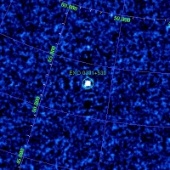ESA Science & Technology - News Archive
News archive
News archive
Published: 14 April 2005
Published: 31 March 2005
On 31 March 2005 at 20:05 UT, Cassini performs its fifth targeted encounter with Saturn's largest moon. At closest approach the spacecraft's altitude above Titan's surface will be just over 2400 kilometres.
Published: 30 March 2005
Report on the status of the Cosmic Vision 2015-2025 Programme by the Director of Science at the EGU 2005 Assembly.
Published: 22 March 2005
Published: 14 March 2005
Scientists using XMM-Newton have discovered an x-ray glow on Jupiter due to x-rays from the Sun being reflected back off the planet's atmosphere.
Published: 7 March 2005
Using ESA's XMM-Newton observatory and the European Southern Observatory's Very Large Telescope, scientists have discovered the most distant massive structure in the Universe.
Published: 2 March 2005
Published: 1 March 2005
Around the time of the descent of the Huygens probe in Titan's atmosphere on 15 January 2005, ground based observations of Saturn's largest moon were made with the Very Large Telescope (VLT) in Chile during the nights from 14-16 January.
Published: 1 March 2005
Scientists using XMM-Newton have observed a relativistic Fe line in the mean X-ray spectra of type-1 and type-2 active galactic nuclei.
Published: 23 February 2005
On 10 February, the ESA Science Programme Committee approved unanimously the extension of the Cluster mission, pushing back the end date from December 2005 to December 2009.
Published: 18 February 2005
Published: 17 February 2005
Published: 16 February 2005
The SMART-1 mission has been extended for an extra year of lunar operations and will now end in August 2006. Among other opportunities, this extension will allow for an increased global coverage by the different dedicated science instruments.
Published: 15 February 2005
More than 100 participants from ISWT and collaborating teams attended a lively and productive workshop with many new exciting scientific results.
Published: 10 February 2005
Multipoint measurements from the Cluster spacecraft have revealed, for the first time, a direct observation of a three dimensional geometry for a hitherto unexplained type of magnetic reconnection.
Published: 4 February 2005
The Hubble Space Telescope's latest image of the star V838 Monocerotis, taken with the ACS instrument, shows the continuing changes in the appearance of surrounding dusty cloud structures.
Published: 3 February 2005
Published: 26 January 2005
The High-Mass X-ray Binary V 0332+53 (EXO 0331+530), currently undergoing a dramatic outburst, was a Target of Opportunity (TOO) for an INTEGRAL observation on 6-10 January 2005.
Published: 20 January 2005
—
20 Items per Page















